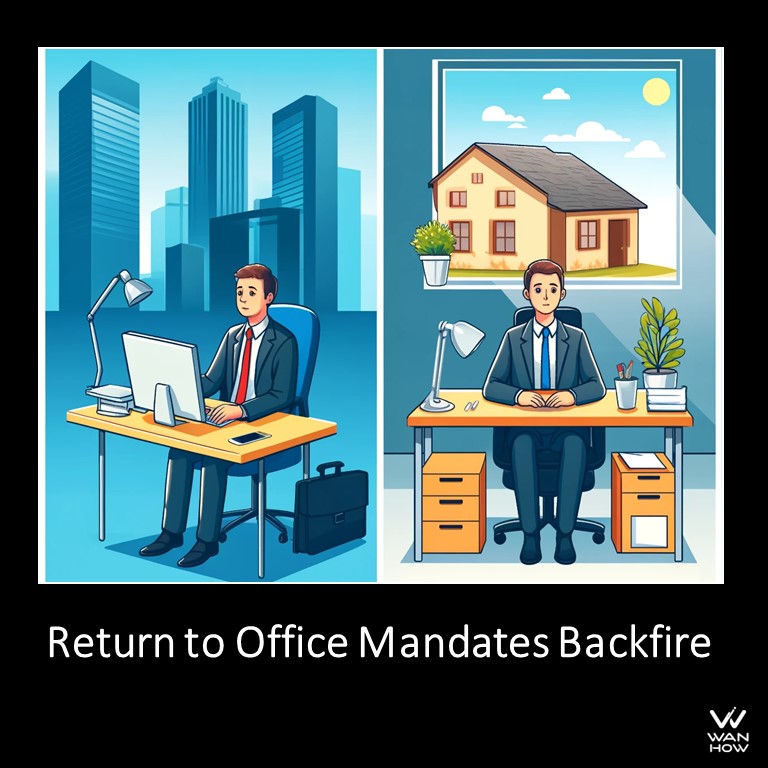
In recent years, the debate over hybrid versus in-office work has intensified, drawing significant attention from both employees and employers worldwide. Research and real-world examples increasingly show that companies enforcing strict return-to-office (RTO) mandates experience higher turnover rates, lower employee morale, and, ultimately, poorer financial performance. This article explores the negative impacts of these mandates and highlights notable cases where CEOs advocating for RTO policies have stepped down from their roles.
The Impact of Return-to-Office Mandates
1. Higher Turnover Rates:
Research by Mark Ma and Yuye Ding from Pitt Business reveals that companies with enforced RTO mandates saw a sharp decrease in employee job satisfaction. This dissatisfaction often translates into higher turnover rates, as employees seek out employers offering more flexible work arrangements. For instance, Glassdoor shifted to a fully remote model after observing that remote job postings attracted 50% more applicants with better qualifications. This move reflects a broader trend where rigid RTO policies push talented employees towards more accommodating companies.
2. Lower Morale:
Ma’s research also indicates that enforced RTO mandates lead to conflicts between managers and employees. The resistance to returning to a pre-pandemic work model is strong, as employees have grown accustomed to the benefits of remote work. These benefits include reduced commuting time, better work-life balance, and increased productivity. When forced to abandon these advantages, employee morale plummets, leading to a less engaged and more resentful workforce.
3. Decreased Sales and Financial Performance:
Despite the argument that in-office work boosts productivity and the bottom line, Ma’s research found no significant changes in financial performance or firm values post-RTO mandate implementation. Instead, the rigid policies often backfire, resulting in decreased employee engagement and productivity. Additionally, companies face the financial burden of maintaining large office spaces that are increasingly underutilized.
Case Studies: CEOs and Return-to-Office Mandates
Several high-profile CEOs who pushed for RTO mandates have faced significant backlash, leading to their resignation or policy reversal. One notable example is Marissa Mayer, the former CEO of Yahoo. In 2013, Mayer enforced a strict RTO policy, which resulted in a 30% loss of Yahoo’s workforce. The policy’s failure contributed to Mayer stepping down, and her successor quickly reversed the mandate.
Another recent example involves Deutsche Bank, which banned remote work on Fridays and Mondays, sparking widespread employee discontent. The backlash was so severe that many employees took to internal messaging boards to voice their dissatisfaction. Similarly, Amazon faced massive resistance when it enforced an in-office mandate, with 30,000 employees signing a petition against the policy and over 1,800 pledging to walk out.
The Shift Towards Hybrid Work
The growing resistance to RTO mandates has led to a significant shift in corporate policies. A KPMG survey found that only one-third of U.S. CEOs now expect a full return to office within the next three years, down from 62% the previous year. Many CEOs have recognized the benefits of hybrid work models, which offer a balance between in-office and remote work, catering to employee preferences and enhancing overall productivity.
Furthermore, some companies are exploring even more flexible work arrangements, such as the four-day workweek. These changes reflect a broader recognition that rigid RTO policies are unsustainable and detrimental to both employee well-being and company performance.
Conclusion
The evidence is clear: forced return-to-office mandates result in higher turnover rates, lower morale, and decreased sales. Companies that cling to outdated work models risk losing their top talent and falling behind in a competitive market. As more CEOs embrace hybrid work, the future of work seems poised to prioritize flexibility, employee satisfaction, and sustainable business practices. By doing so, companies can foster a more engaged, productive, and loyal workforce, ultimately driving better business outcomes.
Sources
- https://www.utimes.pitt.edu/news/study-return-office
- https://fortune.com/2024/04/12/kpmg-study-us-ceos-accept-hybrid-working-employee-return-to-office/
